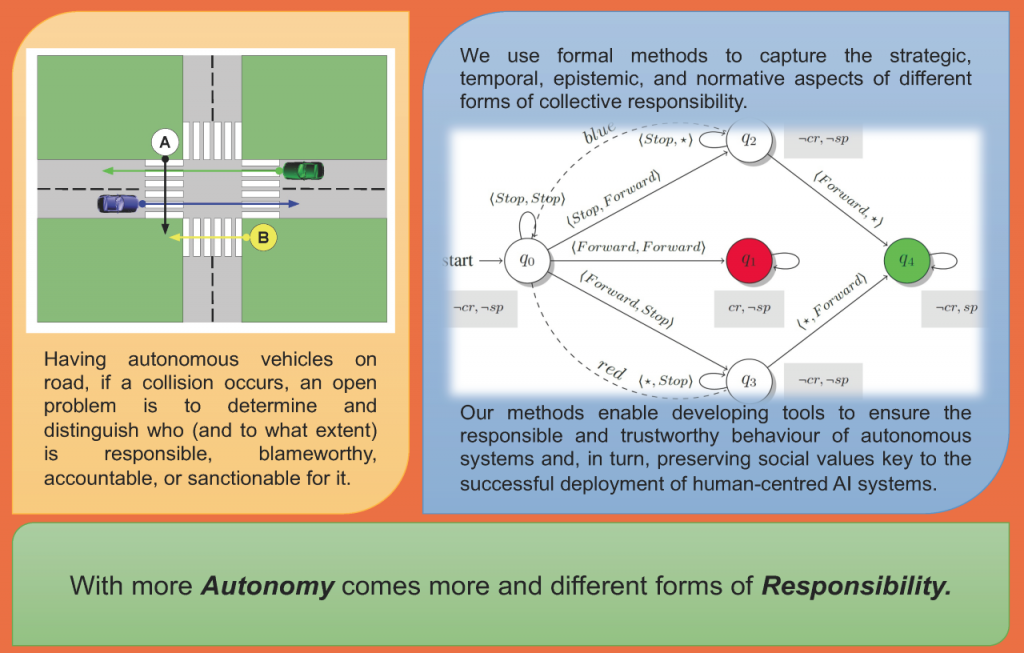Current Projects
Markets for Multi-Modal Transportation
Multi-modal transport is about combining different means of transportation for getting to your destination, e.g. trains and buses, but also taxis, e-bikes and, in future, autonomous cars. While current apps, including Google Maps, are able to suggest a multi-modal journey, these apps do not take into consideration personal preferences and constraints, e.g. time versus costs, the ability and preference to walk or renting a bike, etc. They also do not consider on-demand services such as ride sharing and taxis in combination with public transport. In addition, different providers can compete to provide the service for different parts of the journey.
To realise this vision, many challenges need to be addressed. First, it is important to model and elicit preferences, and using this as part of the optimisation. Second, to facilitate competition, a market mechanism needs to be developed where transportation services are procured from a variety of providers. Different from regular procurement/auction markets, this market will need to deal with multiple trips at the same time and they need to form a coherent journey to the destination. Therefore, it is akin to markets for supply chains and combinatorial markets. Techniques from game theory and mechanism design can be used to design the market rules to incentivise “good” behaviour, where there is no need for participants to speculate and/or deceive the mechanism.
Time Travel

Would it be: better connected public transport links? An easier way to see options of getting from A to B? A different schedule for travel? Having a driver? Feeling safer cycling on the road? Simply spending less time on the road?
This is a question the Time Travel project is exploring. We’d like to understand what would make Travel Time into time well spent.
To fill gaps between public transport, and employees getting to Microsoft buildings in Redmond, Washington USA, Microsoft started a Connector Shuttle Service to make it easier for folks to get to and from work, and to and from various campuses. Do we need a connector service? Would the cost of taking pressure off parking offset that cost/benefit? How do we support building services dynamically based on demands? Do we need a Zip Car service close by?
In this first phase of the project, to help answer this and related questions, the Time Travel Project is building the most detailed model ever of our campus community’s travel patterns. We’ll share the ways we get to work to identify where the challenges are.
Community Transport-Data Governance
Transport data, like other types of data, has a range of stakeholders; from the individuals whose journeys are recorded in the data, through transport operators, to public sector bodies such as highways authorities, planning authorities, and bodies tasked with promoting environmentally-friendly transport. Encouraging re-use of transport data is one way to help realise social and environmental benefits, but different stakeholders are impacted in different ways by data sharing and consequently need to maintain a level of trust that data is being used responsibly and in line with their wishes. Data Institutions are one model to promote responsible data re-use by fostering data governance through a dedicated legal entity.
This project seeks to understand the design requirements for a Data Institution to govern citizen-sourced transport data. The research will contribute to our knowledge about how to build trustworthy data intermediaries that enable data use and re-use in smarter transport networks.
We’re exploring and understanding citizen’s concerns about the use and reuse of transport data, and their positive aspirations for how it should be used (to promote sustainable transport, etc.) and identifying potential governance arrangements and associated “technical underpinnings” that might be applicable to a data institution for Zero Carbon Rugeley, or other transport data governance cases.
Responsibility in Autonomous Mobility

By giving more autonomy to AI-based systems, one cannot still see them as object-like tools that merely follow instructions. For instance, a semi-autonomous vehicle is not receiving direct instructions thus, when collisions occur, it is unfair to see the driver as the only responsible agent. In such systems of human-AI partnership, it is crucial to have effective methods to determine who is, and to what extent they are, responsible. However, the notion of responsibility is traditionally defined in terms of social, epistemic, and moral capacities of humans. To effectively deploy autonomous mobility solutions, and ensure their embedding in society, we are interested in developing novel notions of responsibility able to capture subtleties of non-human autonomy and, in turn, desired characteristics of human-AI partnerships in the context of autonomous mobility.
This line of interdisciplinary research aims at (1) identifying the conceptual links between the notion of autonomy and responsibility in connected and autonomous vehicles; (2) conceptualising how different levels of autonomy in autonomous vehicles relate to different forms of responsibility, accountability, blameworthiness, and liability; (3) formalising legal principles based on the jurisprudential perspective on responsibility; (4) Integrating value-based design methods to ensure responsibility in and by design; and (5) developing automated responsibility reasoning tools for human-centred autonomous mobility.